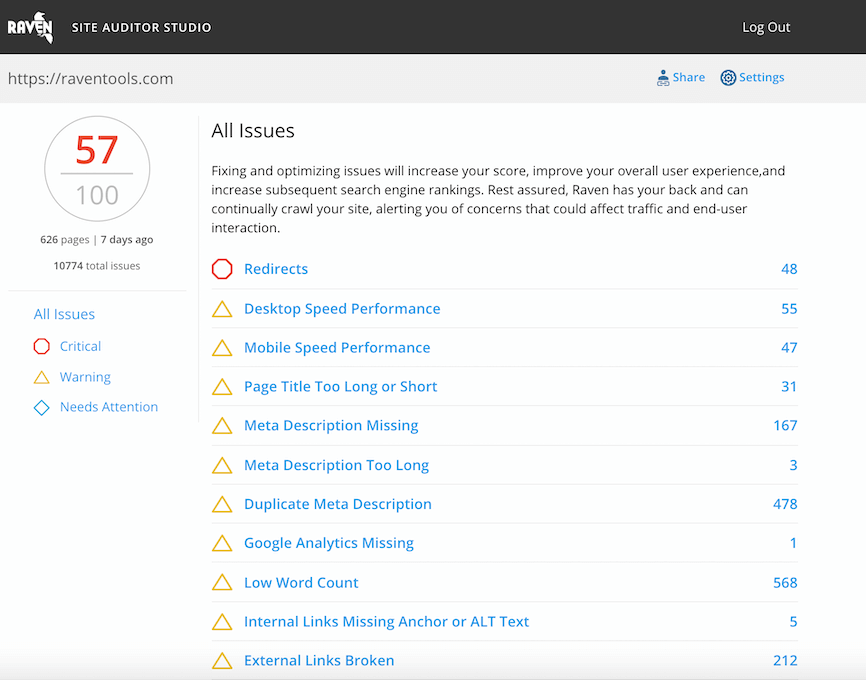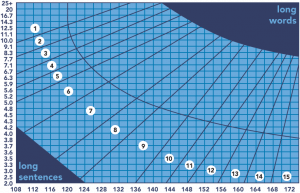“In my younger and more vulnerable years my father gave me some advice that I’ve been turning over in my mind ever since. ‘Whenever you feel like criticizing any one,’ he told me, ‘just remember that all the people in this world haven’t had the advantages that you’ve had.’”
Can you read the above paragraph easily?
If so, count yourself one of the lucky literate. (Give yourself bonus points if you recognized this introduction from The Great Gatsby.)
While the CIA’s The World Factbook may put the literacy rate of most highly developed nations at 99%—where those age 15 and older can read and write—that doesn’t account for how many can read and write well, or even comfortably. In the United States, one out of seven people have trouble reading anything more challenging than a single sentence, much less a string of them or a series of paragraphs. And in the United Kingdom, one in six struggles with literacy.
If you want what you write to influence the most people possible, you must take readability into account. If you’re not an expert in readability, there are standard tests that can measure it for you before you publish.
What’s readability?
Here’s a fun exercise in lack of readability: search online for a simple definition of it. You’ll find:
- Reading ease, especially as it results from a writing style.
- The quality of written language that makes it easy to read and understand.
- Characteristic of printed messages that are easy to read and understand.
- The level of difficulty in a written passage.
- The reading comprehension difficulty of a text.
I bet we can simplify things. How about this?
Readability is how easy your writing is to read.
What influences readability?
Readability depends on lots of things…
- how you write
- how your reader reads (slowly or quickly)
- where your reader reads (a quiet library or a noisy cafeteria)
- what your reader is reading (a paperback book or an e-Reader)
- what experience your reader has (beginning or advanced)
…and so on.
Readability can even depend on how your writing is presented or designed. Before I made the items above a bullet-point list, for example, I had them all in one paragraph separated by semicolons. They’re easier to read now. If I make the type small, bold and italic, that can affect readability. How words look crosses over into legibility and graphic design, however, and you might not be able to control that.
You definitely can’t control all the factors that influence your reader, either.
But you can control how you write.
For readability, write simply, with focus
For the best readability, keep your words simple and your message clear.
Reduce the number of words in your sentences. Reduce the number of sentences in your paragraphs. Possibly, reduce the number of paragraphs in your article.
Basically, how quickly can you make your point? Write exactly that long.
Your punctuation, style and tone can all affect readability. Compare this passage from NewYorker.com about tennis champion Roger Federer:
Although the match lacked drama, it was exciting to watch Federer roam the court like an apex predator, unhurried but poised for the kill. He was in control on nearly every point, pulling Hewitt out of position with precisely placed but subtly varied ground strokes—topspin, slice, half-volley—and finishing with a flat rocket into the open court. I was struck by the way he moved—the quick, balletic footwork that allowed him to stop and change direction much faster than anyone else—and by the classical grace and élan of his strokes. He made the most difficult shots look easy, and even in close matches he rarely seemed to perspire. Federer does not grunt or groan when he hits the ball, as many players do now (Nadal included), nor does he exhort himself after winning points by violent fist-pumps and groin thrusts, or beseech the gods of tennis to witness his frustration when he misses.
to this passage from ESPN.com:
Perhaps what makes Federer’s appeal the greatest is nostalgia for a time when athletes didn’t have tattoos, weren’t accused of abusing steroids, were graceful in victory and defeat, and remained true to their wives. We see him in the way that we see the world through the Instagram photos that have become so popular: grainy, stylized, vintage, classic. Would it surprise any of us if he showed up at Wimbledon this summer in pleatless white trousers? Perhaps not.
to this passage from an Associated Press article:
“If it seems Roger Federer breaks one record or another every time he wins a match, that’s because he does these days. Then again, good as Federer is, he can’t top this: His next opponent at the French Open, Belgium’s David Goffin, is unbeaten in Grand Slam main-draw matches. (OK, so the kid’s only 3-0, but still.)”
As each audience gets more broad the language gets simpler, more casual. Even if you don’t know or care anything about tennis, do you have a favorite?
Subjectively speaking, that’s your readability comfort level. But what if you need to write to a different readability standard?
Put readability to the test
Objectively speaking, there are common readability standards and tests. You can use them to practice writing styles that are at your audience’s reading level. Use one or more of these tests regularly at first, and over time, you won’t need to test everything you write to know whether you have overwritten (or underwritten).
Here are descriptions of the eight most common readability tests for the English language, with recommended writing levels. Below is a list of the online tools that measure one or, in most cases, several of these readability factors.
Cloze test
- Description: A Cloze test removes selected words from a sample of your text and asks readers to fill in the missing words. As online usability expert Angela Coulter wrote for A List Apart, “It’s based on the Gestalt theory of closure—where the brain tries to fill in missing pieces—and applies it to written text.” Coulter recommends a sample text length of 125-250 words with every fifth word removed. Aim for 25-50 blanks. Score answers by counting the number of correct answers and dividing that by the total number of words removed.
- Recommended writing level: You’re looking for a score of 60% or better. Scores in the 40-60% range mean your readers might have difficulty reading the text. Rewrite anything below 40%. (Angela administered a Cloze test at ConFab 2011 with credit card fine print. Everyone in the room scored far below 40%. I’m pretty sure this won’t get you out of late payment penalties, though.)
Flesch Kincaid Reading Ease
- Description: This is one of the oldest readability scores, commonly used in academics and government and incorporated into most word processing software. The Flesch-Kincaid Reading Ease score is the result of a mathematical formula that incorporates the average number of syllables per word and the average number of words per sentence for a 100-word block of text. Results are measured on a scale of 1-100.
- Recommended writing level: On the 1-100 scale, 1 is very complicated to read and 100 is very easy to read. Most readability resources recommend writing to the 60-70 range.
Flesch-Kincaid Grade Level
- Description: Like the Flesch-Kincaid Reading Ease score, this is a mathematical formula that measures syllables and sentence length. However, the results are given as an academic grade level, from 0-12. Negative results are rated at 0, and any grade level over 12 is listed as 12. The Flesch-Kincaid Grade Level score was developed after the Reading Ease score to make it easier for parents, librarians and others to make decisions about reading content for children.
- Recommended writing level: That depends on your audience, but 7th-8th grade is a good standard—that captures more than 80% of U.S. adults.
Gunning Fog Index
- Description: The Gunning Fog Index takes into account “complex” words, those with three or more syllables, as part of its mathematical formula for readability. It also omits proper nouns, jargon and compound words. The result? A grade-level score from 1-unlimited.
- Recommended writing level: According to UsingEnglish.com, “the New York Times has an average Fog Index of 11-12, Time magazine about 11. Typically, technical documentation has a Fog Index between 10 and 15, and professional prose almost never exceeds 18.” The ideal score is between 7 and 8, depending on your audience.
Coleman Liau Index
- Description: Unlike most other readability tests, the Coleman Liau Index relies on number of characters instead of syllables per word for its calculation. It returns a U.S. grade-level score from 1-12.
- Recommended writing level: 7-8, depending on your audience.
SMOG Index
- Description: It’s debatable whether SMOG is short for “Simple Measure of Gobbledygook,” but this index developed in 1969 is still a common measure of readability. Take 30 sentences (10 from the beginning, middle and end of your text), then count every word with three or more syllables in each group of sentences, then calculate the square root of that number and round it to the nearest 10, then add 3 to that number. Voila! You have the U.S. grade level that should be able to read that text. (And that’s one of the simpler of these readability formulas.)
- Recommended writing level: 7-8, depending on your audience.
Automated Readability Index
- Description: The Automated Readability Index (ARI) mathematical formula has two variables: characters per word (instead of syllables, similar to the Coleman Liau Index) and words per sentence. It has been around since 1967. Its scores correspond to U.S. grade levels. If you get a score result with a decimal, round up to the next whole number.
- Recommended writing level: 7-8, depending on your audience (noticing a pattern yet?).
Fry Readability Graph
- Description: The Fry Readability Graph is just that—a graph—on which you’ll need to plot some data that you have already measured. First, pick three random 100-word passages from a book or article. Next, find the average number of syllables and average number of sentences per 100 words. Finally, plot them on the Fry Readability Graph to find the grade level of the text.
- Recommended writing level: Again, this depends on your audience, but writing for a 7th-8th grade reading level is a good place to start.
Readability test online tools
Most of these tools are extremely easy to use, although results can vary slightly from test to test. Use one or more to compare results, or find your favorite and stick with it. Fair warning: the user interfaces vary from utilitarian to ugly.
- Learnclick.com: Cloze test creator.
- L.george.online.fr: Cloze test creator.
- Martineau.tv: Cloze test creator.
- Readability Test Tool: Measures Flesch-Kincaid Reading Ease, Flesch-Kincaid Grade Level, Gunning Fog Score, SMOG Index, Coleman Liau Index and Automated Readability Index. Can test an entire web page or a block of text.
- Microsoft Office Outlook and Word: Measures Flesch-Kincaid Reading Ease and Flesch-Kincaid Grade Level. Tests content in your document.
- Juicy Studio: Measures Flesch-Kincaid Reading Ease, Flesch-Kincaid Grade Level and Gunning Fog Score. Tests an entire web page.
- Dairy Science and Food Technology: Measures Flesch-Kincaid Reading Ease, Flesch-Kincaid Grade Level, Gunning Fog Score, Coleman-Liau Index, SMOG Index and Automated Readibilty Index. Tests a block of text.
- ReadabilityFormulas.com: Measures Flesch-Kincaid Reading Ease, Flesch-Kincaid Grade Level, Gunning Fog Score, Coleman-Liau Index, SMOG Index and Automated Readibilty Index, as well as the Linsear Write Formula. Tests a block of text.
- OnlineUtility.org. Measures Flesch-Kincaid Reading Ease, Flesch-Kincaid Grade Level, Gunning Fog Score, Coleman-Liau Index, SMOG Index and Automated Readibilty Index. Tests a web page or a block of text.
- Joe’s Web Tools. Measures Flesch-Kincaid Reading Ease, Flesch-Kincaid Grade Level, Gunning-Fog Score, Coleman-Liau Index, SMOG Index and Automated Readability Index. Tests the block of text you’re writing in the tool.
- ClarityGrader Tool.Grades website content using Flesch-Kincaid reading ease and grade level tests. It also highlights the use of passive voice and long sentences.
- Edit Central. Measures Flesch-Kincaid Reading Ease, Flesch-Kincaid Grade Level, Gunning Fog Score, Coleman-Liau Index, SMOG Index and Automated Readibilty Index. Tests a block of text.
- UsingEnglish.com. Measures the Gunning Fog Index, Coleman-Liau Index, Flesch-Kincaid Grade Level, Flesch-Kincaid Reading Ease, Automated Readability Index, SMOG Index and the Lix formula—if you register for a free membership. Tests a block of text, but membership comes with perks: UsingEnglish.com will store a history of your tests.
- Mancko.com. For English, measures Flesch-Kincaid Reading Ease, Flesch-Kincaid Grade Level, Gunning-Fog Score, Coleman-Liau Index, SMOG Index, Automated Readability Index and Lix formula, plus the Dale-Chall Formula and Powers-Sumner-Kearl Readability Formula, with explanations for each. Also includes Spanish and French readability tests. Tests a block of text.
Finally, for mathematical formulas, charts and even more (!) readability test metrics, see this readability resource from Ideosity.
Flickr reading photo courtesy of Peter Werkman. Flickr Roger Federer courtesy of agkjd.
Ultimate list of Ultimate lists
- Ultimate list of conversion optimization tools
- Ultimate list of blogging tools for pros
- Ultimate list of PPC advertising tools
- Ultimate list of social media advertising tools
- Ultimate list of online public relations tools
- Ultimate list of PPC bid management solutions

Analyze over 20 different technical SEO issues and create to-do lists for your team while sending error reports to your client.







Wonderful post! If you’re interested, we’ve got a great blog post about Readability Tests and Formulas via Ideosity. http://www.ideosity.com/ourblog/post/ideosphere-blog/2010/01/14/readability-tests-and-formulas?utm_source=Google&utm_medium=Blog&utm_campaign=Raven+Blog+Comment
Great article and one that allowed me to almost complete my entire list of online research questions. Kudos…I bow to your knowledge base 🙂